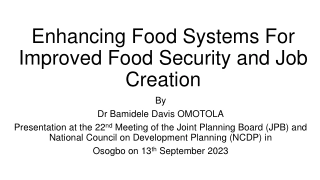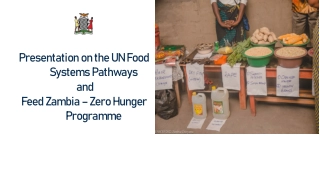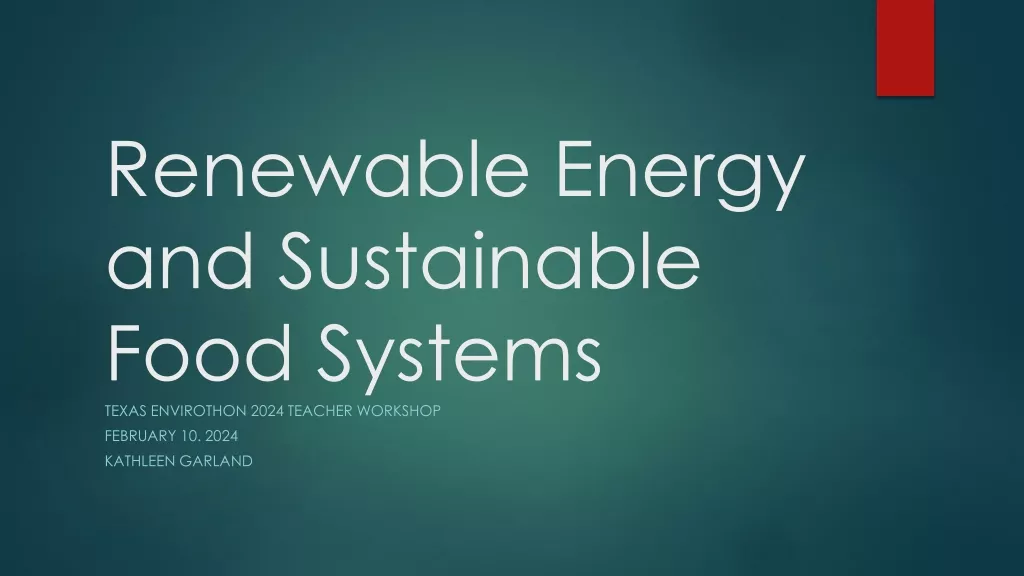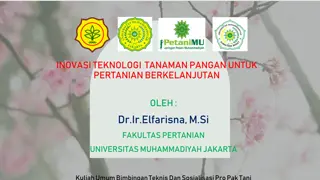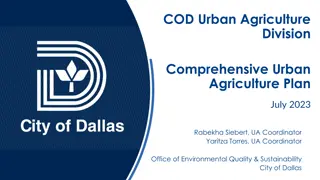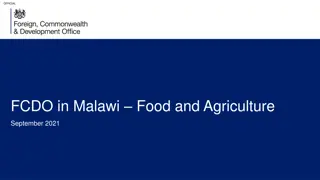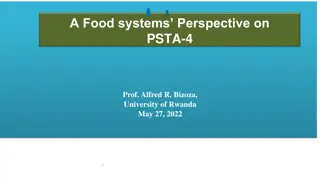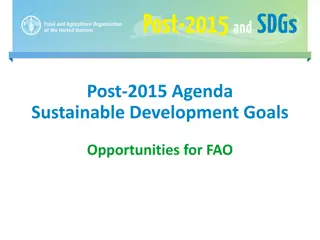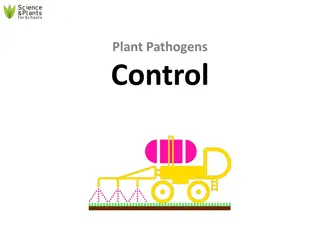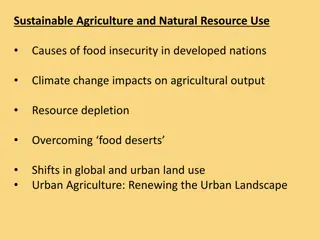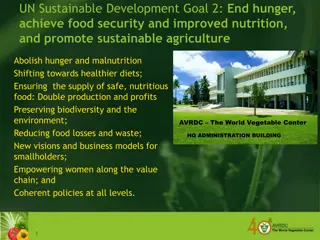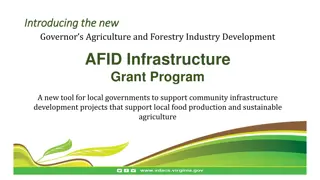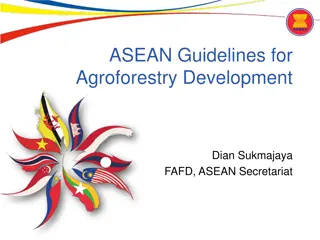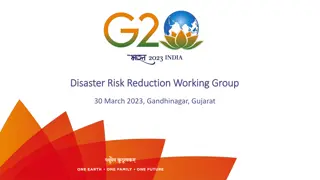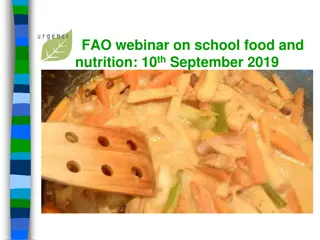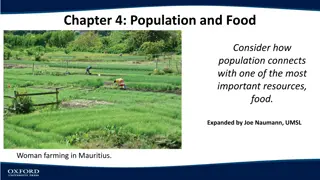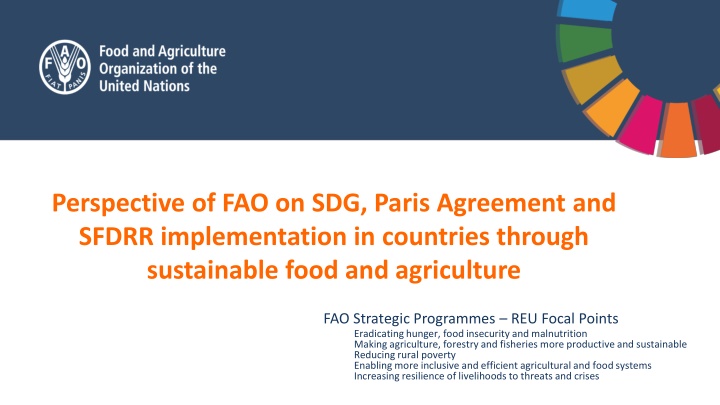
Implementing Sustainable Food and Agriculture for Resilient Systems
Implementing sustainable food and agriculture practices is crucial for achieving SDGs, the Paris Agreement, and Sendai Framework goals. This involves eradicating hunger, increasing productivity, reducing rural poverty, and enhancing resilience to disasters and climate change. Changes in practices can make agriculture more resilient, climate-smart, and sustainable. Examples include integrated systems, crop and livestock improvements, forestry and fisheries co-production, and post-harvest storage enhancements. Enabling environments must support practice changes through national plans, climate commitments, disaster risk management, and efficient supply chains.
Download Presentation

Please find below an Image/Link to download the presentation.
The content on the website is provided AS IS for your information and personal use only. It may not be sold, licensed, or shared on other websites without obtaining consent from the author. If you encounter any issues during the download, it is possible that the publisher has removed the file from their server.
You are allowed to download the files provided on this website for personal or commercial use, subject to the condition that they are used lawfully. All files are the property of their respective owners.
The content on the website is provided AS IS for your information and personal use only. It may not be sold, licensed, or shared on other websites without obtaining consent from the author.
E N D
Presentation Transcript
Perspective of FAO on SDG, Paris Agreement and SFDRR implementation in countries through sustainable food and agriculture FAO Strategic Programmes REU Focal Points Eradicating hunger, food insecurity and malnutrition Making agriculture, forestry and fisheries more productive and sustainable Reducing rural poverty Enabling more inclusive and efficient agricultural and food systems Increasing resilience of livelihoods to threats and crises
Disaster Risks Climate change Sustainability Issues affect and transform all sectors and stages of food and agriculture crop, livestock, forestry, fisheries, aquaculture Sustainable food and agriculture is key to transform national development Growth in the agriculture sectors is one of the most effective means of reducing poverty (SDG1), providing livelihoods. It is key to ending hunger and malnutrition (SDG2) and essential for several SDGs (SDGs 2, 13, 14, 15 and other).
What changes in practices make agriculture and food systems More risk resilient More climate smart More sustainable ? Sendai framework for DRR
Example: changing crop production practices at different stages Input > Production > Storage > Processing > Transport > Consumption > Waste More sustainable? economically? environmentally? socially? More climate-smart? More risk-resilient?
Changing the enabling environment for practice change Examples of practice change options: 1. Integrated systems (livestock-crop-fish, silvo- pastoral, agroforestry,....) 2. Crop: drought/heat-tolerant varieties, nitrogen- efficient varieties, zero-tillage, cover crops, precision agriculture (fertilizer, drip irrigation,..), natural pest predation, rotation mgmt., nutrient-rich crops, vegetables, nuts and fruits... 3. Livestock: adapted breeds, disease resistant breeds, on-farm feed production, manure use, by-product feed... 4. Fisheries and aquaculture co-production 5. Forestry co-production, windbreaks, orchards, energy by-products,... 6. Post-harvest storage facilities 7. Energy-efficient cooling systems 8. Local supply chains, regional/urban markets 9. Climate and weather forecast services 10. Integrated early warning systems, vulnerability & risk profiling, contingency plans 11. Green labelling, certification, standards 12. Food waste reduction measures, etc.. SDG target commitments National development plans, sectoral strategies, investment plans Enabling environment to manage cost, benefit, risk of practice change Climate change commitments Disaster risk commitments
Assessing potential practice changes needs to cover all stages of agricultural and food production and consumption Five principles of sustainable food and agriculture aim to - enable dialogue across agricultural sectors and stakeholders along value chains and at different levels - ensure balanced sustainability and consistency of actions - encourage collaboration and enhance overall contribution to sustainable development
Possible next steps 1. Map relevance of SDG targets, climate and DRR commitments <-> agri-food sectors 2. Raise awareness of key role of food and agriculture in national SDG, climate and DRR agenda 3. Identify and address information gaps, particularly on SDG indicators 4. Enter into dialogue on possible actions with stakeholders: dialogue with the private sector and other stakeholders is essential for making progress 5. Identify possible actions for upcoming multi-year plans, determining contributions to SDG targets and costs and check possibilities to mobilizing (budget) funding and investments
THANK YOU Perspective of FAO on SDG, Paris Agreement and SFDRR implementation in countries through sustainable food and agriculture FAO Strategic Programmes REU Focal Points Eradicating hunger, food insecurity and malnutrition Making agriculture, forestry and fisheries more productive and sustainable Reducing rural poverty Enabling more inclusive and efficient agricultural and food systems Increasing resilience of livelihoods to threats and crises

